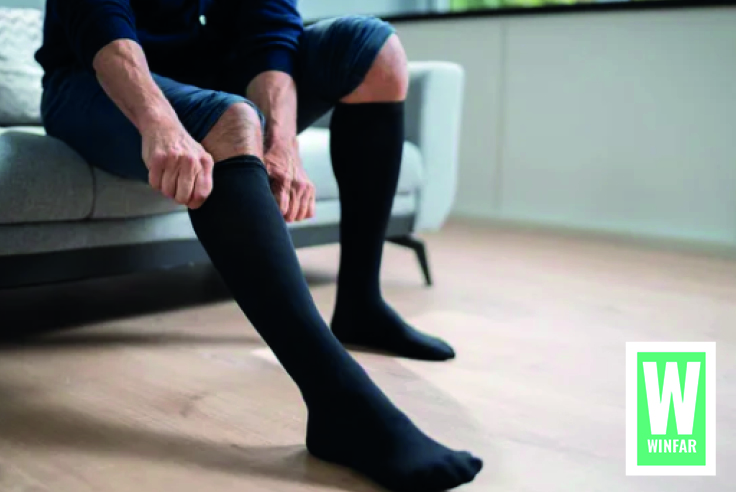If you struggle with Oedema (swelling of the ankles, feet and legs), lymphoedema (when the bodies tissues swell), or varicose veins, you may have wondered if compression socks would be a good idea. In 90% of cases, yes, they can be. But, there are exceptions. So, before you simply run off and buy a pair at the local pharmacy, we did the research for you. Here is what you need to know.
What are compression stockings for?
Compression socks work by promoting improved blood flow from your legs to your heart. Gently pushing blood flow up the leg, helping to prevent swelling and even blood clots. By applying pressure to the legs, they reduce the extra fluid in the legs, reduce inflammation, and ultimately improve blood flow through h the veins to the heart. Besides venous insufficiency, another common reason for wearing compression socks is to aid in blood flow when you’re sitting for long periods of time.
Who should not use compression socks?
While many people can benefit from compression socks after surgery, during pregnancy or as legs become achy, swollen or heavy feeling. There are exceptions. Thus, the best place to start is with a visit to your GP to evaluate your circulation.
Medical compression socks and stockings are prescribed by a doctor for various venous and lymphatic ailments. However, there are times that a compression garment is not ideal.
A compression garment should not be worn in the case of circulation disorders in leg arteries or for those with serious heart conditions. The increased pressure will simply exasperate the problem.
Caution is also recommended in the case of sensory impairments due to diabetes and neuropathy (nerve damage), placing them at increased risk of complications.
How do compression socks work?
“Nearly 90% of leg disorders originate within the veins,” Georgeanne Botek, DPM
Compression socks are designed to help reduce swelling in the feet, legs and ankles by squeezing your lower extremities. This works by using graduated compression, where the highest pressure is at the ankle, and then gradually reduces further up the leg. The applied pressure forces fluid away from swollen tissues and sends it up towards your upper body.
The result: improved circulation of blood through the veins, and the healthier movement of lymphatics fluids reducing swelling.
It also reduces the ability of superficial veins to expand and fill with blood, which prevents that blood from flowing backwards and causing congestion. If blood pools in the veins of the legs, it can cause a variety of problems including skin changes, damage to vein walls and valves, inflammation of the vein, varicose veins and even blood clots.
But, not all compression socks are created equal.
Compression stockings come in a variety of sizes, lengths and colours. They’re also available with different strengths of compression. Before you rush out a buy a pair, chat to your doctor.
There are two important things you need to know before selecting compression socks: the amount of compression and the size needed.
Your health care provider will advise the compression level you need and measure your leg to ensure you are fitted in a proper compression sock.
According to Vein specialist Eugene Ichinose, M.D. “The quality of the material, the sizing, the durability and the amount of compression or pressure the garment provides all culminate in the final product. Some very economical support hose are not sized by careful measurement of your leg. They are labeled small, medium and large, however the amount of compression provided is not known.”
Dr. Ichinose advises his patients to pay close attention to the color of their toes and report any differences in the colour of their toes from the foot or leg to your health care provider.
Types of compression socks:
You will generally find two types of compression socks: graduated and anti-embolism stockings. As always, be sure to check with your healthcare provider before making a decision
- Graduated compression socks are the more common. While available in a range of compression tightness, these socks are all tightest around the ankle, getting looser the higher up the leg they go.
- Anti-embolism stockings are more specific in purpose. They’re designed to help maintain circulation, thus preventing blood clots, for bed-bound patients, particularly those confined to bed after surgery.
Who could benefit from wearing compression socks?
Compression socks can be beneficial for many conditions. Your doctor may recommend you wear compression socks for:
- Boosting circulation in the legs
- Decreasing swelling in the legs and ankles
- Improving lymphatic drainage
- Managing orthostatic hypotension, or low blood pressure when you stand up after a period of sitting down
- Preventing blood from pooling in the leg veins
- Preventing deep vein thrombosis in the legs
- Preventing venous ulcers
- Reducing pain related to varicose veins
- Reversing venous hypertension
Compression socks can also be useful for:
– people on their feet all day at work, compression socks can help reduce fatigue, pain or swelling by increasing blood and oxygen flow in the legs and feet.
– someone who is confined to a wheelchair, compression socks can help improve blood flow and reduce swelling in the legs.
How long should I wear compression stockings to improve my circulation?
If you have received a prescription for compression stockings to address a circulatory condition, you might be required to wear them for an extended period, which could even extend to a lifelong commitment. The usage may be necessary for either both legs or just one, depending on your specific circumstances.
In addition, even for those who are prescribed to wear compression, it is best practice to remove your medical compression stockings when you go to sleep. Your venous and lymphatic system does not work against gravity when you lie down. This facilitates the drainage of blood and lymph. In addition, skin regenerates overnight.
And remember: You should have your legs measured again and your stockings replaced every 3 to 6 months.
DISCLAIMER: This website does not provide medical advice. This information, including text, graphics, images, and other material contained on this website is for information purposes only. No material on this site is intended to be a substitute for professional medical advice, diagnosis, or treatment. Always seek the advice of your physician or other qualified health care provider with any questions you may have regarding a medical condition or treatment before undertaking a new health regime, and never disregard professional medical advice or delay in seeking it because of something you have read on this website.
Sources:
What you need to know about compressions socks
https://oklahomaheart.com/blog/what-you-need-know-about-compression-socks-you-buy
https://www.riversideonline.com/patients-and-visitors/healthy-you-blog/blog/c/compression-socks-what-are-they-and-who-needs-them
https://www.mediusa.com/help-center/when-not-to-wear-compression-socks
https://www.nhs.uk/common-health-questions/accidents-first-aid-and-treatments/how-long-should-i-wear

